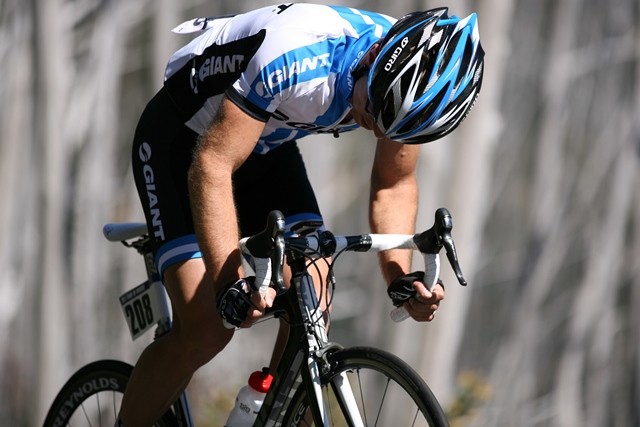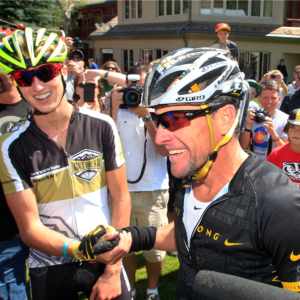Is Eddy right?
Which is more efficient; to pedal at high cadence or to pedal at low cadence?
If you’re a recreational rider, it probably doesn’t matter because outright efficiency or power isn’t your major interest. If you race or otherwise consider yourself a ‘performance’ rider then the answer is important. Let’s look at a couple of examples of performance riding to see what we can learn.
The Hour Record is considered to be one of the toughest tests possible for a performance cyclist. Average cadence for successful Hour record breakers has varied between Graeme Obree’s 95 rpm to a high of 104 rpm with the majority of successful attempts being at or slightly above 100 rpm. That cadence range would be considered as moderately high for a sustained effort by most cyclists.
Next, we have identical twins of the same weight, riding hard, side by side on identical bikes, on the same hill and at the same speed. By definition they must be producing the same power. In this example, Twin 1 is riding the big chain ring at 60 rpm while Twin 2 has selected the small chain ring and a cadence of 90 rpm. Which one will sustain the high intensity effort longest?

Intuitively, almost everyone answers “Twin 2” and they’re right but why?
A lower cadence means a higher peak torque per pedal stroke. (Torque is the pressure a rider applies to the pedals x crank length. Power is torque x rpm.) A higher peak torque means a stronger peak muscular contraction per pedal stroke and the stronger the peak muscular contraction, the higher the production of fatigue metabolites. By way of comparison, the climber at 90 rpm has a much lower peak torque / peak muscular contraction per pedal stroke but that is partly offset by the greater number of pedal strokes completed during the same time.
So it appears that it is more economical to ride at a higher cadence. Scanning the research, this isn’t necessarily so. There are a number of studies available that have concluded that low cadences of 50 -70 rpm are more economical than pedaling above 90 rpm. However, the common factor amongst these is that the subjects of the study were either recreational riders or, if they were trained cyclists, the power outputs the subjects were asked to produce during the study were relatively low. That means for a performance rider, these findings are open to question.
In 2004 a trial was conducted, mainly in Spain, on pro cyclists using power outputs of 300 watts plus and some of it at above 350 watts. These are outputs that quality cyclists can sustain, not social riders. It found that the most efficient cadence tended to rise as power output increased, at least among highly trained and well adapted pro cyclists. It concluded that while there were individual differences, at high intensity, riding at 60 rpm is less efficient and more fatiguing than when pedaling at 80 – 100 rpm.

So it appears that Eddy was right. For best performance we need to pedal a big gear relatively fast.
While that’s the case, the type of training a rider performs can move the most efficient cadence up or down the scale somewhat. We tend to become good at what we do and less good at what we don’t practice. If you slug away all the time in the big chain ring you will become relatively strong, but lose the ability to accelerate quickly. In contrast, if a rider pedals consistently at higher cadences they will improve their ability to do so but possibly at the cost of losing the strength needed to monster a gear when necessary. In an effort to nail down an efficient way to train for a typical time poor cyclist, I turned to Carl Paton, a Professor of Exercise Science in Napier, New Zealand who has vast experience as a cycling coach, racer and researcher.
Carl co-authored a 2009 study that appeared in the Journal of Strength and Conditioning Research entitled “The Effects of Low vs High Cadence Interval Training on Cycling Performance”. To summarise, a group of cyclists, each with a minimum of 3 years racing experience and in the middle of their competitive season were divided into matching pairs based on power output. Each rider of each pair performed the same 2 x weekly sessions of high intensity intervals, with the difference being that the low cadence group completed them at 60 – 70 rpm, while the high cadence group pedalled at 110 -120 rpm.
After 8 sessions over 4 weeks, with a minimum of 48 hours recovery between interval sessions, improvements were noted in both groups. The low cadence group registered higher increases than the high cadence group in testosterone levels, power output, maximal oxygen uptake and a number of other factors. In most parameters measured, the improvement of the low cadence group over the high cadence group was significant.

Which leads to this: It appears that for a trained, performance cyclist producing high outputs, pedaling faster at 90 rpm plus is more efficient than pedaling slower at 70 rpm or less. But to develop the strength necessary to “pedal a big gear fast” to use Eddy’s words, low cadence intervals are necessary.
For those interested, below is a 10 week program that Carl Paton prescribes to time poor cyclists who race while holding down a full time job and having all of the usual family responsibilities.
This program is for time poor cyclists, assumes a cycling background and no great tendency to injury. Be careful and use commonsense.

10 WEEK PRE SEASON PROGRAM TO INCREASE STRENGTH
You will need an indoor trainer with handlebar mounted resistance control or other means of massively increasing resistance; a 350mm – 400 mm high step or box and a pair of running shoes. For Weeks 1 —4 & Weeks 9 – 10 elevate the front of the bike so it is 50 — 80 mm above horizontal and vary the amount of elevation above horizontal for each session. This will ensure that your relationship to gravity and hence, pattern of muscular enlistment, is similar to what it would be climbing a variety of gradients.
Weeks 1—4
Tuesday and Thursday: 50 minutes
• Zero – 10.00: warm up at 70% of max heart rate @90 – 100rpm
• 10.00 — 14.30: 5 x 30 seconds on, 4 x 30 seconds off. The on 30 seconds to be in the biggest gear that can be pushed at the highest resistance level that can be managed at 60 — 70 rpm at maximum effort. For the off 30 seconds, switch resistance back to normal and change to small ring. Do not pick top gear for this. Use a higher resistance level on the trainer. Choose at least a couple of gears lower than top gear so that you have somewhere to improve to over the course of the program. If, because of fatigue, you can’t maintain 60 rpm, change down a cog. If you go above 70 rpm, change up a cog. Show some self-discipline with this and reap the rewards
• 14.30 — 16.30: Two minutes easy pedaling at any resistance and cadence that seems appropriate.
• 16.30 — 19.30: one minute to put running shoes on, one minute to do 20 x plyometric spring jumps on each leg [ stand with one leg on 350 – 400 mm high block or step and leap as high as possible, taking off with the leg on the block. Repeat 20 times and then swap legs], then one minute to get cycling shoes back on and get back on the bike. Most will be able to do this in less than three minutes total and that’s fine. Get back on the bike earlier and pedal in an easy gear.
• 19.30 —20.00: easy pedaling.
• 20.00 — 30.00: Repeat 10.00 — 20.00
• 30.00 —40.00: Repeat again
• 40.00 — 50.00: warm down at 70% of max heart rate @ 90 — 100rpm
• Saturday and Sunday: Long rides of whatever distance @ 70% of max HR and if you have to ride up hills do not go above 75% max HR.
The Tuesday and Thursday intervals, if performed conscientiously will take more out of you than you realise. If you have not totally recovered from weekend rides by Tuesday, you will find the intervals will suffer.
Weeks 5—8
Tuesday and Thursday: 48 minutes
• Minute Zero — 10.00: same warm up as before
• 10.00 — 14.00: biggest gear you can push at the highest resistance @ 90 — 100 rpm. As before, don’t choose your highest gear so as to allow somewhere to improve to. If you drop below 90 rpm because of fatigue, change down a gear. If you end up pedaling above 100 rpm, change up a gear. Ideally choose a gear that allows you to complete the entire interval with EFFORT. This is far better than having to sequentially change down gears during an effort because you have chosen too hard a gear.
• 14.00 — 18.00: easy pedaling at 80 — 90 rpm in any gear that you choose but don’t let heart rate drop below 70% of max heart rate
• 18.00—38.00: repeat the 4 minute efforts 3 more times with 4 minute easy pedaling break at 70% max HR in between.
• 38.00 —48.00: you have just finished your 4 x 4 minute effort. Warm down at 90 — 100 rpm at 70 % of max heart rate.
• Saturday and Sunday: Keep up the long steady rides at low intensity.
Weeks 9 and 10
Same as Weeks 1 — 4
Now you should be in a position to go racing. Every 5 — 6 weeks during the season, take 2 weeks off whatever your program is and repeat 2 weeks of Weeks 1 – 4. This will ensure that power output continues to increase during the season.
Tip: During your recovery periods, it is a good idea to change into your ‘effort’ gear five seconds before the interval starts so you are primed to go and don’t have to waste time.


